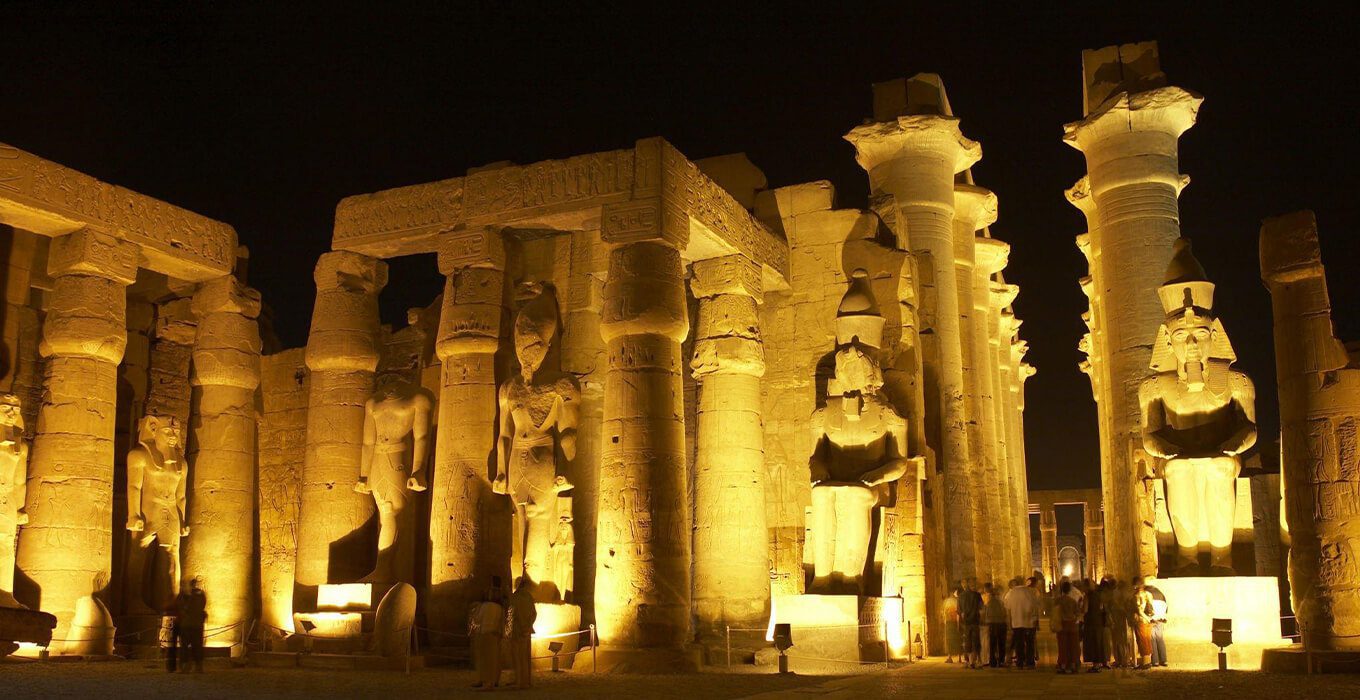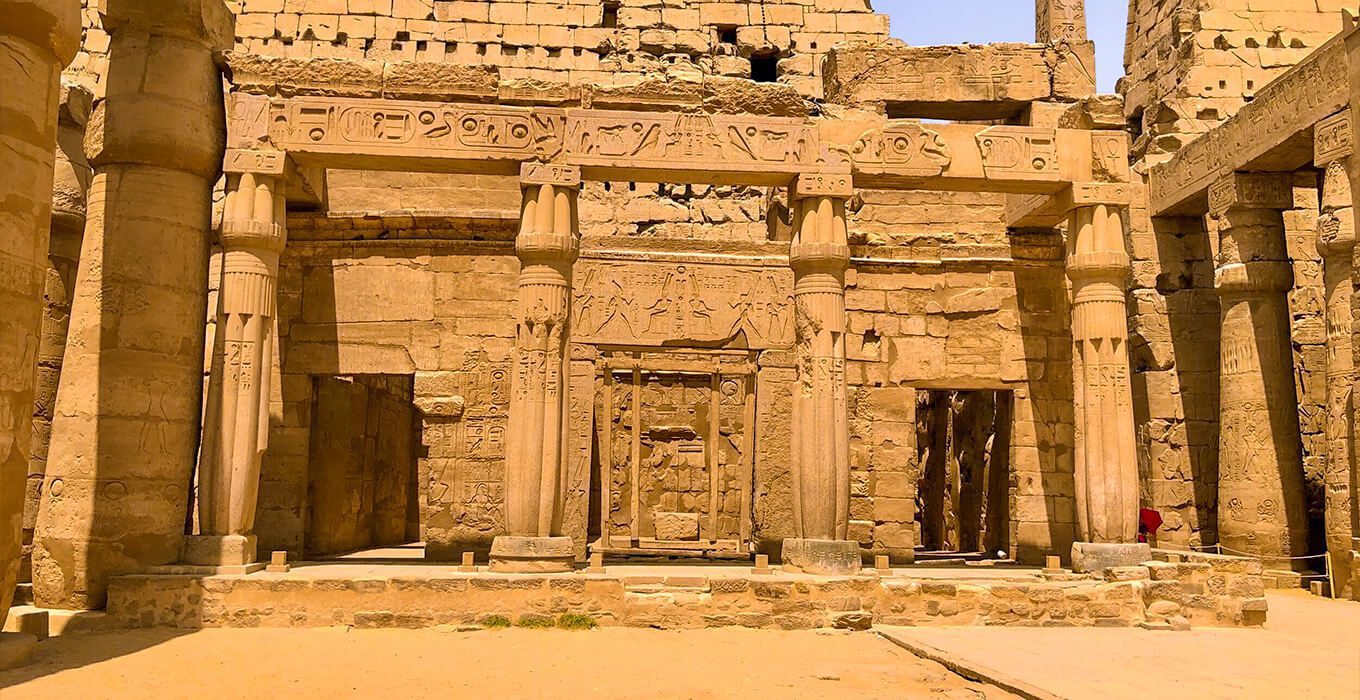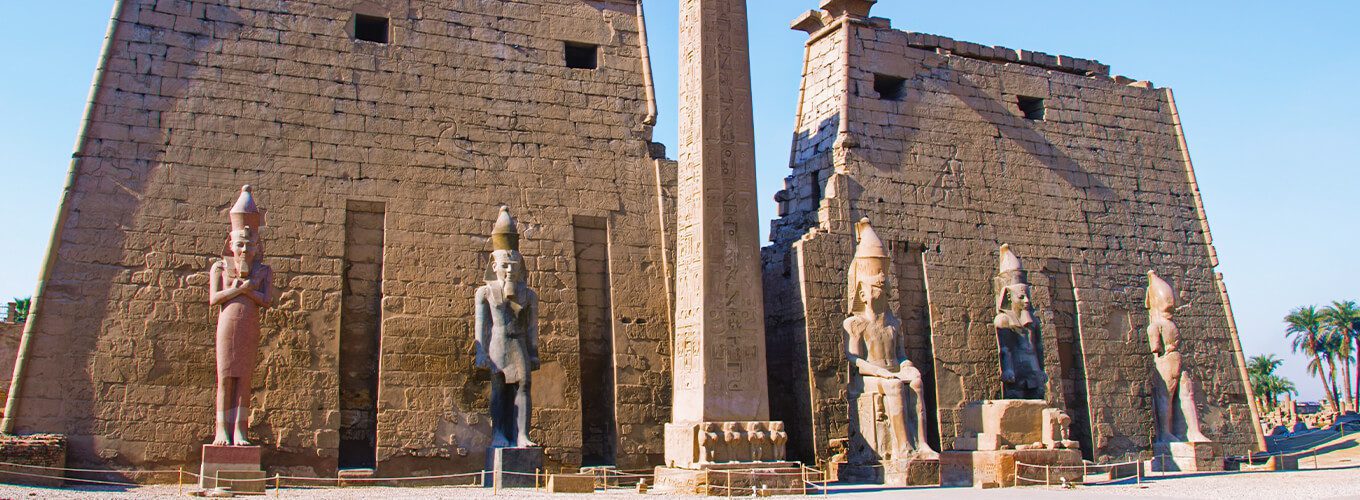Luxor Temple in Luxor city stands as one of Egypt’s oldest and most breathtaking structures, a testament to the splendor and power of the Pharaohs, notably under the reign of Amenhotep from 1391 to 1353 BC. This magnificent monument, located on the east bank of the Nile River, is a captivating destination for tourists eager to explore the rich culture and history of the pharaohs.
A profound reflection of the pharaohs’ thoughts and labor during that era, Luxor Temple bears witness to the shifts in history and politics. The temple features two vast and exquisite obelisks, one proudly standing in Luxor and the other, regrettably stolen, eventually discovered in Paris at the iconic Place de la Concorde.
Intriguingly, the king’s inscriptions adorn the temple’s first door, providing a captivating narrative of Pharaonic history and culture, detailing the life of King Ramesses II and his triumphant victory in the Battle of Kadesh. The doors boast six statues, each meticulously crafted by skilled artisans, while 72 pillars are a testament to the temple’s grandeur.
Luxor Temple is a remarkable architectural marvel and an eloquent storyteller of the pharaohs’ legacy. Delve into the captivating history and cultural richness etched into every stone of Luxor Temple, where the past comes alive, inviting modern-day explorers to witness the enduring majesty of ancient Egypt.
Elevate your travel experience with unparalleled opulence on our Luxury Egypt Vacations. Begin your journey of a lifetime today!
Exploring the Grandeur of Luxor Temple in Egypt
Situated on the banks of the Nile in the city of Luxor, it is a mesmerizing testament to the architectural prowess of the New Kingdom. Once the capital of the pharaohs, Luxor showcases the grandiosity, ostentation, and disciplined elegance characteristic of this era.
The sheer scale of the complex is awe-inspiring, stretching 260 meters from the entrance to the northern wall. The entrance towers stand tall at 20 meters and boast a base length of 70 meters. As you approach, the eye is drawn to two majestic statues of Ramses, remnants of the original six. Adjacent to the entrance, a striking obelisk crafted from pink granite further enhances the Temple’s regal ambiance.
A notable feature of the Luxor Temple complex is the Sphinx Alley, once called the “Sacred Way.” This majestic path, adorned with 1350 sphinxes, connected Luxor Temple and the Temple of Karnak.
The tower’s tiny entrance leads to a colonnaded courtyard. Along the eastern part of the arcade, remnants of a mosque stand about 8 meters above the ground. Beyond the colonnade lies an older courtyard, showcasing the inner temple with a hypostyle hall boasting 32 columns adorned with intricate Egyptian carvings.
The inner temple walls bear stucco from the Roman period, with a chapel from ancient Rome once located there. This chapel served as a site where the local population renounced their faith and adopted the state religion.
Adjacent to this is a temple commissioned by Alexander the Great, adorned with ancient paintings depicting the Sun God. Luxor Temple, with its rich history, still harbors many mysteries. Not all its secrets have been unraveled, and scientists anticipate many more remarkable discoveries within this complex. Luxuriate in the allure of Luxor Temple, where the echoes of ancient civilizations reverberate through its magnificent structures.
Unlock the secrets of ancient civilizations with unparalleled comfort on our Luxury Egypt Tours. Your luxury adventure awaits!


The Enduring Heritage of Luxor Temple, Egypt
- Luxor Temple, often hailed as the cornerstone of Luxor’s status as “the largest open-air museum in the world,” stands proudly amidst the modern city. Situated on the site of the ancient Egyptian capital, Thebes, this temple is a testament to the country’s rich history.
- As one of the oldest and impeccably preserved structures in Egypt, Luxor Temple is a captivating mosaic of rooms, buildings, and bas-reliefs, offering visitors an enthralling journey into Luxor’s past and Egypt’s profound heritage.
- Set against the Valley of the Kings, few places encapsulate Egypt’s fascinating history as vividly as Luxor Temple. Built during the New Kingdom by the visionary Pharaoh Amenhotep III (1390 BC–1352 BC), a ruler committed to civilization and architectural progress, the temple reflects his desire to enhance Egypt’s capital and urban infrastructure.
- Ramesses II, another prolific builder and pharaoh of great renown, further contributed to the temple’s grandeur. He repurposed existing monuments while engaging in extensive construction projects, leaving an indelible mark on the statues and bas-reliefs that grace Luxor Temple.
- The city’s most iconic structures, Luxor Temple and Karnak Temple, grace the eastern bank of the Nile, historically connected by a remarkable 30-kilometer avenue of sphinxes. Although undergoing excavation, the section closest to Luxor Temple has already been meticulously restored.
- Luxor Temple, a marvel of ancient history, transcends mere architectural significance. Easily accessible at any time of the day, its allure is heightened at sunset or nightfall when the lighting gracefully illuminates the intricate relief sculptures on its walls.
- it was dedicated to the Theban triad of Amon, Mut, and Khonsu during the New Kingdom. It hosted the annual Opet feast, a fertility rite where an Amon statue traveled along the Nile from the nearby Karnak Temple.
- Initiated in the 14th century BC during Amenhotep III’s reign, subsequent rulers like Haremhab and Tutankhamun contributed to the temple’s evolution. However, Ramses II made pivotal changes, leaving an enduring legacy.
- Remarkably, Luxor Temple is unique among Egyptian temple complexes, bearing the names of only two rulers inscribed on its sacred structures. Explore the rich tapestry of Luxor Temple, where every stone narrates the timeless story of Egypt’s majestic past.
Imagine a holiday designed just for you. With our Egypt Tailor Made Holidays, your personalized Egyptian escape begins here.
Fascinating Tidbits


Opet Festival Extravaganza: The Opet Festival marked an annual celebration in ancient Egypt, commemorating the sacred union of Amun and the goddess Mut. This grand event unfolded in a magnificent procession, where small flat-bottomed boats carried the divine spouses and their sons from the Karnak temple to Luxor along the Sphinx, creating a splendid spectacle.
Obelisk Exchange: Two obelisks crafted from pink granite were originally at the entrance to Luxor Temple. However, one of these obelisks embarked on a unique journey in the early nineteenth century. The ruler of Egypt presented it to the King of France in exchange for a French clock—a somewhat uneven barter, especially considering the clock’s less-than-perfect functionality.
2018 Discovery Delight: The Luxor Temple revealed another layer of its secrets. A captivating find in the Sphinx Alley unfolded—a statue featuring a lion with a human head. Strikingly reminiscent of the colossal Sphinx near the Cairo pyramids, this discovery added a new dimension to the historical richness of the temple’s surroundings.
From the Great Pyramids to the Nile’s serene waters, our Egypt Trip Planner helps you discover Egypt’s treasures tailored just for you.
Conclusion
Luxor Temple is probably one of the most famous places in Egypt, right next to the Karnak Temple. There were two builders: Amenhotep III. and Ramesses II. However, buildings from the era of Hatshepsut and even from the Middle Kingdom seem to be present in Egypt.
The total length of the Temple is more than 250 meters. Dedicated to the god Amun, the divine origin of the pharaoh was celebrated here. With its ground plan, it emphasizes the idea of a festival temple. It was the background for the deity’s path in processions such as the Opet Festival, the Knot Festival, and the Valley Festival.
Related articles:
